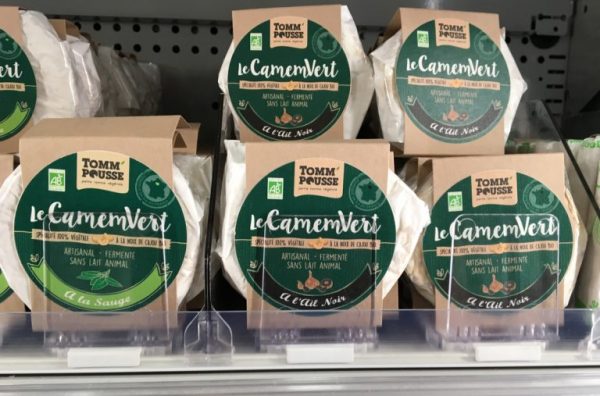Food by Design continually examines the way we buy, cook, eat and experience our food. When we understand that, it is easier for food brands, formulas, producers and retailers to anticipate and innovate. For 2020, we delightfully share five important food trends for 2020. Curious about the whole story, focused on your category? … Please contact us.
Food trends 2020 –
1 #Eating for biodiversity
A lot has been written about sustainable eating, recently. The transition to a plant-based diet, the prevention of food waste and the reduction of the plastic soup have received a lot of attention. The next important theme is contributing to biodiversity. Monocultures are threatening the planets biodiversity. Endless large plantations of corn, rice, wheat, soy and palm oil make plant and animal species disappear. Although the world has more than 50,000 edible plants, rice, corn and wheat provide as much as 60% of our energy needs. The first food brands begin to incorporate this theme into their ‘ brand purpose ‘. For instance, Knorr and the World Wildlife Fund, has created a list of 50 crops to eat more often, and to promote less monotonous and more biodiverse food choices. Another example is the brand Weideweelde (Rich meadow), a dairy milk that motivates their cow farmers to grow more weeds in the grass, attracting more insects and thus more different bird species. It is our prediction that this theme will be put on the menu more often the coming years.

Food trend 2020: Food for biodiversity, cooperation between Knorr and WWF to stimulate a more biodiverse food choice.
Food trends 2020 –
2 #New calorie counting
Over the past 15 years, we have seen many health philosophies and diets come by. And many got tired about all these new food rules about what’s good to eat and what not. It seems to bring us back in time to our mothers who simply counted calories with the Weight Watchers in the Seventies and Eighties. The idea is back: Calories matter! It is not about avoiding specific foods, but it much more about eating less often, less energy rich. But since the 1970s, our eating environment has changed dramatically and you can buy food anywhere and anytime, which has increased the temptation of more often and bigger portions enormously. At the same time, digital health trackers have made their appearance. Wrist watches track every step, breath and burnt calorie. Now that we have easier insight into the calories we burn, the need to know our intake in an easy way is growing quickly. No complicated calculations, but packaging and menu cards in combination with digital technologies will provide us with this knowledge. Forerunner in this trend is the American ice-cream brand Halotop that sells low calorie ice-cream pints with the number of calories, printed very big on front of the pack. For example, the Caramel Machiato ice-cream contains 280 kcal while a normal pint contains more than a thousand calories. In no time they managed to gain 5% of the market share of the American ice market. When a product is sensory delightful but it manages to keep calories low, one has gold in his hand. There are great opportunities for this trick in categories like desserts, pastry, ice-cream on chopsticks, cakes and candy. But it doesn’t always have to be about smart ingredient formulations. Smaller portions fit well in this thinking too. We watched a wonderful assortment of mini pastry at the Belgian chain Exki with small muffins, cannelés and Pasteis de nata. There is also a golden future for the mini Magnum, when this popsicle would be available out of home as a single pack.

Food trend 2020: Counting the new calories. The successful Halo top mentions large the number of calories on the packaging.
Food trends 2020 –
3 #Plant based cheese
The dominant food trend at this moment is the shift from animal to plant based proteins. We have already written a lot about the plant based trend in recent years. Previously the accent was mainly on meat substitution, now comes the most difficult of all: vegan cheese. Not easy to make and match the taste of animal milk cheese. But the experiments are massively going on and people are enthusiastically trying to implement the bacterial and fungal cultures (which give cheese their characteristic flavour) on mixtures of vegetable fats and proteins e.g. cashew nut milk and potato protein. Not a bad idea, because when we look at the CO2 footprint per gram of protein, cow’s milk cheese is just behind beef. And the climate impact is even higher than that of chicken meat. This new cheesing craft goes beyond the making of standard Dutch, Gouda cheese. In France, we already spotted a shelf full of camemvert, blue cheese, vicotta, mozzarella and soft herb cheeses. An interesting development that for sure will come with new tasty, alternatives in the nearby future.

Food trend 2020: Plant based cheese ‘Camemvert’
Food trends 2020 –
4 #Comeback of the potato
In the last decade we were forgetting this humble stable food, when we were musing about low carbs. But now, this brown yellowish tuber is back in the spotlight. Nutritious, culinary multi-functional, creative and environmentally friendlier than other carbs; Pasta and rice (e.g. smaller CO2 footprint and less land use). When not fried, potatoes are healthy. The number of calories is modest, 75-80 kcal per 100 grams of boiled potato, and it is a source of many vitamins and minerals. He is nutritional not doing less than the currently praised sweet potato. They are both super foods. The Spaniards had already found out when they set foot in the Americas in 1492 and watched the strong Inca’s who ate a lot of potatoes. Anno 2020 the potato is used more and more creatively, next to cooking, frying and cutting into fries, they are transformed into noodles, pizza bases, waffles and savoury cakes (latkes). And it is not only about the tuber itself, they are generously topped with vegetables, meats, sauces and all sorts of sprinkles. For example, the fries of German Frittenwerk are almost pieces of art. Next to that the potato is interesting to decompose. For instance, the proteins and starches are processed separately to become vegan egg and cheese substitutes. See for examples the company ‘Free From that‘ that offers cheese and omelette mixes. The starches are also increasingly used as bio-degradable plastics in packaging.

Food trend 2020: Comeback of the potato in creative applications such as latkes.
Food trends 2020 –
5 #Earthy colours and flavours
A true rainbow hysteria has erupted over the past 3 years on Instagram, now comes the time we have enough of rainbow Poké Bowls, unicorn frapuccinos and pink ravioli. Almost every trend creates its own counter trend. So does this one. In the coming year, the appeal of bright colours (so 2018!) shifts to the warm, earthy colour tones and flavours. It becomes the time of 50 shades of brown. Brown relates to where our food comes from; The soil, the earth. Soil conditions will become a more important theme; How do farmers care for the soil? … Do they rotate crops, stimulate a rich soil life full of insects and give their soil rest once in a while? Crops with earthy flavours such as mushrooms, potatoes (see above), carrot and tuber vegetables, nuts, coffee, chocolate, spices and fermented products go well with this trend wave. Earthy flavours are created by geosmin, a protein produced by fungi and bacteria. We humans are incredibly sensitive in our ability to taste this protein. A little too much, can create an off-taste quickly. Subtly dosed, however, can it give an interesting flavour depth to products or dishes. Innovative chefs have been doing experiments already. For example, the Japanese chef Nariswa made edible earth of nuts, raisins and mushrooms for the guests of Rene Redzepi. Apart from the fact that it contained Geosmin, it was also rich in the much-praised umami. And of course, there is the effect of the soil on taste of produce. In wine it is very common to speak about the ‘ terroir’, but we will hear this more and more in other types of food. In packaging, crockery and the interior of restaurants we will see this earth trend through the use of colours like chocolate brown, chestnut, rust, terracotta, brick red, ochre yellow, sage green and clay grey. And yes, even on Instagram, the earth flavours and colours will show up. The Korean bhog_log is already a good example.

Food trend 2020: Earthy flavours and colours.
Fit for the future?
Do you need food or brand innovation? Don’t hesitate to call Marielle or Marleen to hear the whole story about all food trends for 2020? We can provide you with trend presentations, trendslation & idea workshops and product innovation.

